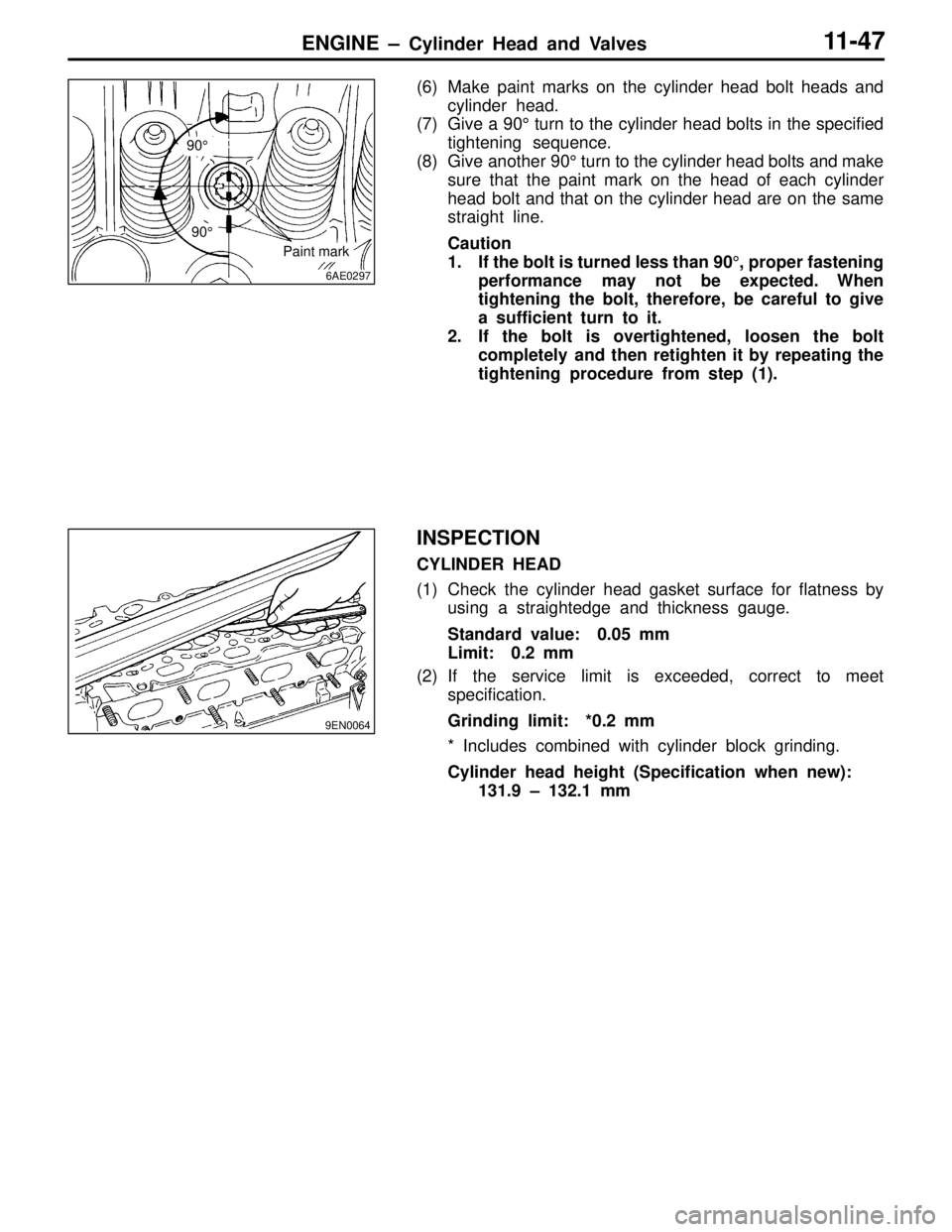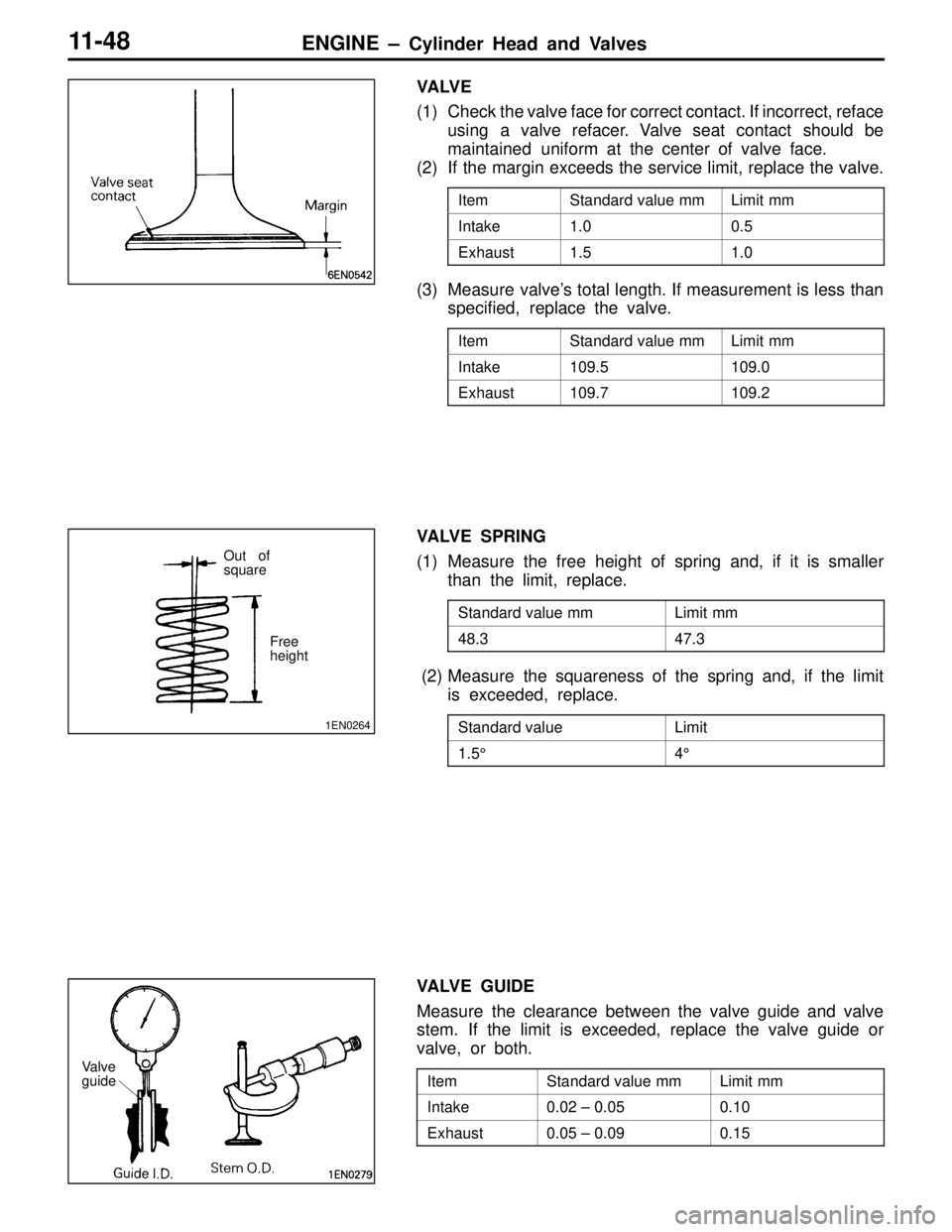Page 71 of 558
ENGINE – Cylinder Head and Valves11-46
�B�VALVE SPRING INSTALLATION
Direct the valve spring end with identification color toward
the spring retainer.
�C�RETAINER LOCK INSTALLATION
The valve spring, if excessively compressed, causes the
bottom end of the retainer to be in contact with, and damage,
the stem seal.
�D�CYLINDER HEAD BOLT INSTALLATION
(1) When installing the cylinder head bolts, check that the
shank length of each bolt meets the limit. If the limit is
exceeded, replace the bolt.
Limit: Max. 99.4 mm
(2) Apply engine oil to the bolt threads and to the washers.
(3) Using the special tool (MB991654) and according to the
tightening sequence, tighten the bolts to the specified
torque.
Tightening torque: 78 Nm
(4) Loosen all bolts fully.
(5) Retighten the loosened bolts to a torque of 20 Nm in
the specified tightening sequence.
MD998772
MD998735
6EN0782
Shank length
Timing belt side
Page 72 of 558

ENGINE – Cylinder Head and Valves11-47
(6) Make paint marks on the cylinder head bolt heads and
cylinder head.
(7) Give a 90° turn to the cylinder head bolts in the specified
tightening sequence.
(8) Give another 90° turn to the cylinder head bolts and make
sure that the paint mark on the head of each cylinder
head bolt and that on the cylinder head are on the same
straight line.
Caution
1. If the bolt is turned less than 90°, proper fastening
performance may not be expected. When
tightening the bolt, therefore, be careful to give
a sufficient turn to it.
2. If the bolt is overtightened, loosen the bolt
completely and then retighten it by repeating the
tightening procedure from step (1).
INSPECTION
CYLINDER HEAD
(1) Check the cylinder head gasket surface for flatness by
using a straightedge and thickness gauge.
Standard value: 0.05 mm
Limit: 0.2 mm
(2) If the service limit is exceeded, correct to meet
specification.
Grinding limit: *0.2 mm
* Includes combined with cylinder block grinding.
Cylinder head height (Specification when new):
131.9 – 132.1 mm
6AE0297
90°
Paint mark
90°
9EN0064
Page 73 of 558

ENGINE – Cylinder Head and Valves11-48
VA LV E
(1) Check the valve face for correct contact. If incorrect, reface
using a valve refacer. Valve seat contact should be
maintained uniform at the center of valve face.
(2) If the margin exceeds the service limit, replace the valve.
ItemStandard value mmLimit mm
Intake1.00.5
Exhaust1.51.0
(3) Measure valve’s total length. If measurement is less than
specified, replace the valve.
ItemStandard value mmLimit mm
Intake109.5109.0
Exhaust109.7109.2
VALVE SPRING
(1) Measure the free height of spring and, if it is smaller
than the limit, replace.
Standard value mmLimit mm
48.347.3
(2) Measure the squareness of the spring and, if the limit
is exceeded, replace.
Standard valueLimit
1.5°4°
VALVE GUIDE
Measure the clearance between the valve guide and valve
stem. If the limit is exceeded, replace the valve guide or
valve, or both.
ItemStandard value mmLimit mm
Intake0.02 – 0.050.10
Exhaust0.05 – 0.090.15
1EN0264
Free
height
Out of
square
Valve
guide
Page 74 of 558

ENGINE – Cylinder Head and Valves11-49
VA LV E S E AT
Assemble the valve, then measure the valve stem projection
between the end of the valve stem and the spring seating
surface. If the measurement exceeds the specified limit,
replace the valve seat.
ItemStandard value mmLimit mm
Intake49.2049.70
Exhaust48.4048.90
VALVE SEAT RECONDITIONING PROCEDURE
(1) Before correcting the valve seat, check for clearance
between the valve guide and valve and, if necessary,
replace the valve guide.
(2) Using the seat grinder, correct to obtain the specified
seat width and angle.
(3) After correcting the valve seat, lap the valve and valve
seat using lapping compound. Then, check the valve
stem projection (refer to VALVE SEAT in INSPECTION).
VALVE SEAT REPLACEMENT PROCEDURE
(1) Cut the valve seat to be replaced from the inside to thin
the wall thickness. Then, remove the valve seat.
(2) Rebore the valve seat hole in the cylinder head to a
selected oversize valve seat diameter.
Valve seat ring hole diameter
ItemStandard value mm
Intake0.30 O.S.35.30 – 35.33
0.60 O.S.35.60 – 35.63
Exhaust0.30 O.S.33.30 – 33.33
0.60 O.S.33.60 – 33.63
(3) Before fitting the valve seat, either heat the cylinder head
up to approximately 250°C or cool the valve seat in liquid
nitrogen, to prevent the cylinder head bore from galling.
(4) Using a valve seat cutter, correct the valve seat to the
specified width and angle.
See “VALVE SEAT RECONDITIONING PROCEDURE”.
DEN0212
Valve stem end
Valve stem
projection
Spring seating
surface
6EN0491
0.9 – 1.3 mm
43.5° – 44°
0.5 – 1 mm
0.5 – 1 mm
1EN0275
Height of
seat ring
Oversize I.D.
Page 75 of 558
ENGINE – Cylinder Head and Valves11-50
VALVE GUIDE REPLACEMENT PROCEDURE
(1) Force the valve guide out toward the cylinder block using
a press.
(2) Machine the valve guide hole in the cylinder head to
the size of the oversize valve guide to be installed.
Caution
Do not use the valve guide of the same size as the
removed one.
Valve gauge hole diameters in cylinder head
ItemStandard value mm
0.05 O.S.12.05 – 12.07
0.25 O.S.12.25 – 12.27
0.50 O.S.12.50 – 12.52
(3) Press-fit the valve guide until it protrude specified value
19.5 mm as shown in the illustration.
Caution
1. Press the valve guide from the cylinder head top
surface.
2. Valve guide for intake valve and that for exhaust
valve are different in length. (45.5 mm for intake
valve; 50.5 mm for exhaust valve)
(4) After the valve guide has been installed, insert a new
valve to check for smooth sliding motion.
1EN0106
Protrusion
Page 82 of 558

ENGINE – Front Case, Counterbalance Shaft and Oil Pan11-57
�M�OIL FILTER INSTALLATION
(1) Clean the installation surfaces of the filter bracket.
(2) Apply engine oil to the O-ring of the oil filter.
(3) Screw the oil filter in until the O-ring contacts the bracket.
Then tighten 3/4 turn (tightening torque: 16 Nm).
�N�DRAIN PLUG GASKET INSTALLATION
Caution
Fitting the gasket in a wrong way will result in oil leakage.
Install the drain plug gasket in the direction shown.
INSPECTION
FRONT CASE
(1) Check oil holes for clogging and clean if necessary.
(2) Check the left counterbalance shaft front bearing section
for wear, damage and seizure. If there is anything wrong
with the section, replace the front case.
(3) Check the front case for cracks and other damage.
Replace cracked or damaged front case.
OIL SEAL
(1) Check the oil seal lip for wear and damage. Replace
oil seal if necessary.
(2) Check the oil seal lip for deterioration. Replace oil seal
if necessary.
6EN0591
Bracket side
Oil pan
side Drain plug
GasketOil pan
Page 83 of 558

ENGINE – Front Case, Counterbalance Shaft and Oil Pan11-58
COUNTERBALANCE SHAFT
(1) Check oil holes for clogging.
(2) Check journals for seizure, damage and contact with
bearing. If there is anything wrong with the journal, replace
the counterbalance shaft, bearing or front case assembly.
OIL COOLER BY-PASS VALVE (ENGINE WITH AIR
COOLING TYPE OIL COOLER)
(1) Make sure that the valve moves smoothly.
(2) Ensure that the dimension (L) measures the standard
valve under normal temperature and humidity.
Standard value (L): 34.5 mm
(3) The dimension must be the standard value when
measured after the valve has been dipped in 100°C oil.
Standard value (L): 40 mm or more
OIL PUMP
(1) Assemble the oil pump gear to the front case and rotate
it to ensure smooth rotation with no looseness.
(2) Ensure that there is no ridge wear on the contact surface
between the front case and the gear surface of the oil
pump cover.
(3) Check the side clearance.
Standard value:
Drive gear 0.08 – 0.14 mm
Driven gear 0.06 – 0.12 mm
Valve
Page 87 of 558
ENGINE – Piston and Connecting Rod11-62
(10)Check that the piston moves smoothly
�B�OIL RING INSTALLATION
(1) Fit the oil ring spacer into the piston ring groove.
NOTE
1. The side rails and spacer may be installed in either
direction.
2. New spacers and side rails are colored for
identification of their sizes.
SizeIdentification color
StandardNone
0.50 mm oversizeRed
1.00 mm oversizeYellow
(2) Install the upper side rail.
To install the side rail, first fit one end of the rail into
the piston groove, then press the remaining portion into
position by finger. See illustration.
Use of ring expander to expand the side rail end gap
can break the side rail, unlike other piston rings.
Caution
Do not use piston ring expander when installing side
rail.
(3) Install the lower side rail in the same procedure as
described in step (2).
(4) Make sure that the side rails move smoothly in either
direction.
6EN1237
Lower side railSpacer
Upper
side rail
1EN0269
Side rail gap